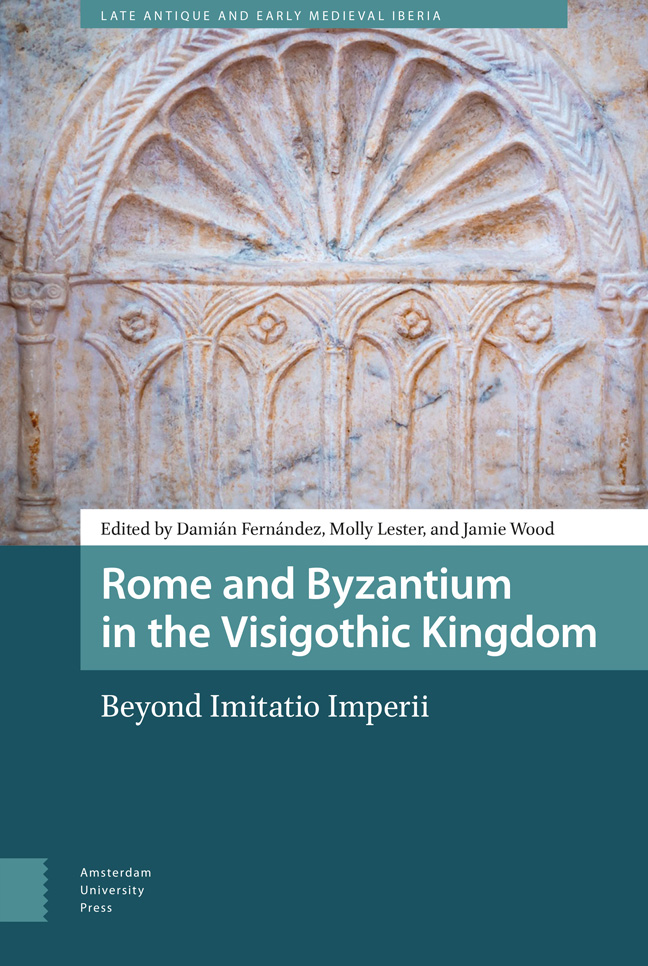Book contents
- Frontmatter
- Contents
- List of Figures and Tables
- Abbreviations
- Acknowledgements
- Maps
- Introduction
- 1 Visigothic Spain and Byzantium: The Story of a Special (Historiographical) Relationship
- 2 The Development of the Visigothic Court in the Hagiography of the Fifth and Sixth Centuries
- 3 Experiments in Visigothic Rulership: Minting and Monetary Reforms under Alaric II
- 4 A Comparison of Roman and Visigothic Approaches to Exile
- 5 The Roman Jewel in the Visigothic Crown: A Reassessment of the Royal Votive Crowns of the Guarrazar Treasure
- 6 Capitalhood in the Visigothic Kingdom
- 7 Making Rite Choices: Roman and Eastern Liturgies in Early Medieval Iberia
- 8 Ethnicity and Imitatio in Isidore of Seville
- 9 Re-imagining Roman Persecution in the Visigothic Passions
- 10 Romanness in Visigothic Hagiography
- 11 Empire and the Politics of Faction: Mérida and Toledo Revisited
- 12 The Agents and Mechanics of Connectivity: The Mediterranean World and the Cities of the Guadiana Valley in the Sixth Century
- 13 Staying Roman after 711?
- Index
13 - Staying Roman after 711?
Published online by Cambridge University Press: 20 February 2024
- Frontmatter
- Contents
- List of Figures and Tables
- Abbreviations
- Acknowledgements
- Maps
- Introduction
- 1 Visigothic Spain and Byzantium: The Story of a Special (Historiographical) Relationship
- 2 The Development of the Visigothic Court in the Hagiography of the Fifth and Sixth Centuries
- 3 Experiments in Visigothic Rulership: Minting and Monetary Reforms under Alaric II
- 4 A Comparison of Roman and Visigothic Approaches to Exile
- 5 The Roman Jewel in the Visigothic Crown: A Reassessment of the Royal Votive Crowns of the Guarrazar Treasure
- 6 Capitalhood in the Visigothic Kingdom
- 7 Making Rite Choices: Roman and Eastern Liturgies in Early Medieval Iberia
- 8 Ethnicity and Imitatio in Isidore of Seville
- 9 Re-imagining Roman Persecution in the Visigothic Passions
- 10 Romanness in Visigothic Hagiography
- 11 Empire and the Politics of Faction: Mérida and Toledo Revisited
- 12 The Agents and Mechanics of Connectivity: The Mediterranean World and the Cities of the Guadiana Valley in the Sixth Century
- 13 Staying Roman after 711?
- Index
Summary
Abstract
Historians of the first half century after 711 rely on the so-called Mozarabic Chronicle, written within the east Roman chronographic tradition. Several statements in the chronicle appear to be corroborated by coins and lead seals with Arabic inscriptions found in the peninsula that also have Byzantine antecedents. This chapter looks at the ways that material evidence for imitation, reinvention, or the strategic adoption of the Roman and Byzantine past can inform the debate about rupture and continuity in Iberia after 711.
Keywords: Islamic conquest of Spain; coinage of al-Andalus; Arabic lead seals; Chronica Muzarabica/Chronicle of 754; Byzantine North Africa
When the Muslims conquered al-Andalus, they found in the city of Qurṭuba [Córdoba] the ruins (‘athār) of a massive bridge that spanned the river, held on several arches of firm pillars, the work of the people of ancient civilizations now vanished, of which only traces remained (al-‘umam al-māḍīa al-dāthara lam yabqā minhā).
Mérida [Mérida] was one of the first places that the kings of the ‘ajm [non-Muslims] and the emperors before them chose to settle as […] a foundation on which to build. It was completed in the time of the Caesar Uktūbiyān [Octavian]. The first Caesar began it and the second Caesar completed it. The rulers visited frequently and renewed the monuments, excellently made, the decorations, and the astonishing marble. They were
able to bring in water stored in a construction known as al-barīqa [from Latin Aqua Barraeca] [which] workmen [both] before […] and after them were incapable of contriving.
When the forces of Ṭāriq ibn Ziyād crossed the Straits of Gibraltar in 711, followed a year later by those of Mūsā ibn Nuṣayr, the governor of North Africa appointed by the caliph in Damascus, they found all around them the material traces of Roman and Visigothic Hispania. In Córdoba, Roman walls, gates, and streets formed the template of the new capital. Visigothic buildings abutting the southern wall of the city served as the palace and administrative centre of the first Umayyad emir, ‘Abd al-Raḥmān I (756–788). The Great Mosque of Córdoba may have replaced a Visigothic basilica on the same site. Roman hydraulic systems were repaired to supply the garden palaces of Rusāfa, al-Rūmanīya, and Madīnat al-Zahrā’ outside Córdoba.
- Type
- Chapter
- Information
- Rome and Byzantium in the Visigothic KingdomBeyond Imitatio Imperii, pp. 345 - 368Publisher: Amsterdam University PressPrint publication year: 2023



